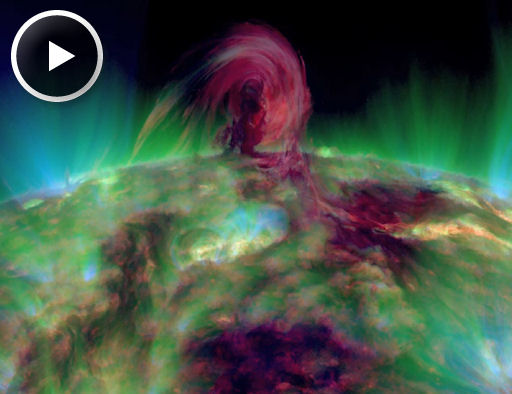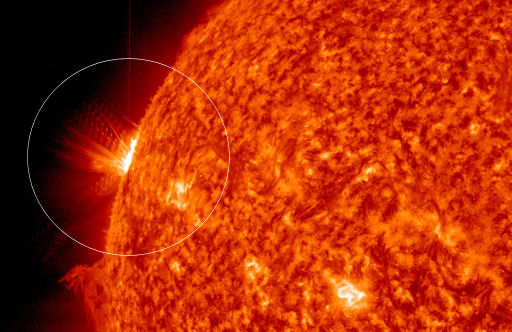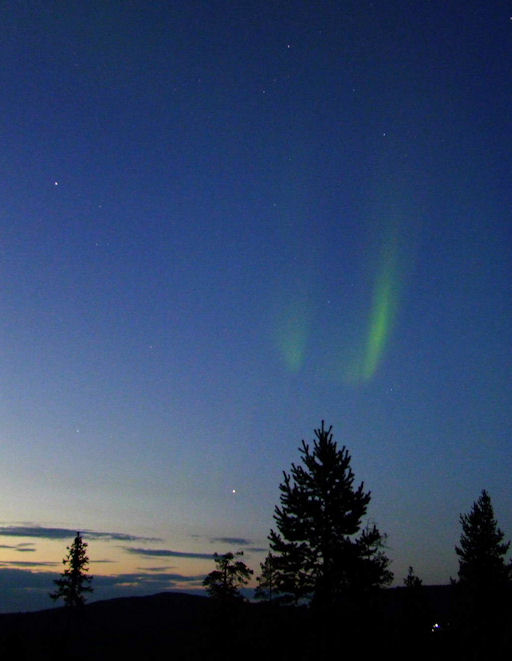They came from outer space--and you can have one! Genuine meteorites are now on sale in the Space Weather Store. | | |
SIGNIFICANT SOLAR FLARE, NOT EARTH-DIRECTED: Magnetic fields snaking over the sun's northeastern limb erupted on August 18th (01:02 UT), producing a significant M5.5-class solar flare. NASA's Solar Dynamics Observatory (SDO) recorded the blast:

The magnetic filament shown erupting above appears to be connected to an active sunspot on the farside of the sun. A great way to see the farside spot is using NASA's 3D Sun app, which shows our star as a 3-dimensional globe that you can spin and inspect from any angle. Download the app and look around the globe for a hot sspot labeled 'farside AR.'That's the farside active region.
Another movie from SDO shows flashes of extreme ultraviolet radiation and plumes of plasma flying over the sun's northeastern limb:

These flares herald the approach of the active region as the sun's rotation turns it in our direction. Soon, it will become an Earthside sunspot group and the eruptions which are missing our planet now could become geoeffective. A significant uptick in solar activity is likely in the days ahead. Solar flare alerts: text, phone.
Realtime Space Weather Photo Gallery
RETURN OF THE ARCTIC AURORAS: It has been a while since sky watchers around the Arctic Circle have enjoyed the Northern Lights. Auroras are hard to see through the glare of the midnight sun. As summer comes to an end, however, aurora season is beginning again. On August 16th, B.Art Braafhart spotted a splash of green over Salla in the Finnish Lapland:

"Finally, after three nights hunting for 'the green lights,' I made the first catch of the new season," says Braafhart. "The nice temperature (+12C) was accompanied by zooming mosquitos around midnight. The apparition was brief, the colors thin and light, but after an absence of 4 months exciting again!" Aurora alerts: text, phone.
Realtime Aurora Photo Gallery
Realtime Noctilucent Cloud Photo Gallery
[previous years: 2003, 2004, 2005, 2006, 2007, 2008, 2009, 2011]
Potentially Hazardous Asteroids (
PHAs) are space rocks larger than approximately 100m that can come closer to Earth than 0.05 AU. None of the known PHAs is on a collision course with our planet, although astronomers are finding
new ones all the time.
On August 18, 2012 there were potentially hazardous asteroids.
Notes: LD means "Lunar Distance." 1 LD = 384,401 km, the distance between Earth and the Moon. 1 LD also equals 0.00256 AU. MAG is the visual magnitude of the asteroid on the date of closest approach. | | The official U.S. government space weather bureau |
| | The first place to look for information about sundogs, pillars, rainbows and related phenomena. |
| | Researchers call it a "Hubble for the sun." SDO is the most advanced solar observatory ever. |
| | 3D views of the sun from NASA's Solar and Terrestrial Relations Observatory |
| | Realtime and archival images of the Sun from SOHO. |
| | from the NOAA Space Environment Center |
| | the underlying science of space weather |

